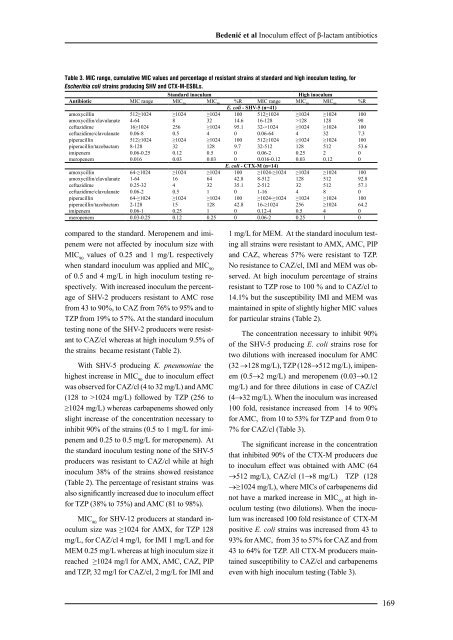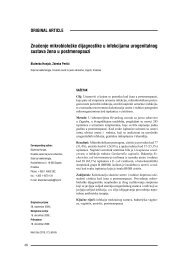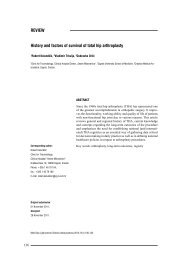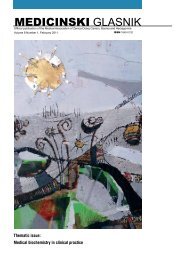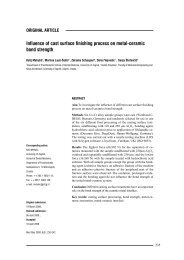MEDICINSKI GLASNIK
MEDICINSKI GLASNIK
MEDICINSKI GLASNIK
You also want an ePaper? Increase the reach of your titles
YUMPU automatically turns print PDFs into web optimized ePapers that Google loves.
compared to the standard. Meropenem and imipenem<br />
were not affected by inoculum size with<br />
MIC 90 values of 0.25 and 1 mg/L respectively<br />
when standard inoculum was applied and MIC 90<br />
of 0.5 and 4 mg/L in high inoculum testing respectively.<br />
With increased inoculum the percentage<br />
of SHV-2 producers resistant to AMC rose<br />
from 43 to 90%, to CAZ from 76% to 95% and to<br />
TZP from 19% to 57%. At the standard inoculum<br />
testing none of the SHV-2 producers were resistant<br />
to CAZ/cl whereas at high inoculum 9.5% of<br />
the strains became resistant (Table 2).<br />
With SHV-5 producing K. pneumoniae the<br />
highest increase in MIC 90 due to inoculum effect<br />
was observed for CAZ/cl (4 to 32 mg/L) and AMC<br />
(128 to >1024 mg/L) followed by TZP (256 to<br />
≥1024 mg/L) whereas carbapenems showed only<br />
slight increase of the concentration necessary to<br />
inhibit 90% of the strains (0.5 to 1 mg/L for imipenem<br />
and 0.25 to 0.5 mg/L for meropenem). At<br />
the standard inoculum testing none of the SHV-5<br />
producers was resistant to CAZ/cl while at high<br />
inoculum 38% of the strains showed resistance<br />
(Table 2). The percentage of resistant strains was<br />
also significantly increased due to inoculum effect<br />
for TZP (38% to 75%) and AMC (81 to 98%).<br />
MIC 90 for SHV-12 producers at standard inoculum<br />
size was ≥1024 for AMX, for TZP 128<br />
mg/L, for CAZ/cl 4 mg/l, for IMI 1 mg/L and for<br />
MEM 0.25 mg/L whereas at high inoculum size it<br />
reached ≥1024 mg/l for AMX, AMC, CAZ, PIP<br />
and TZP, 32 mg/l for CAZ/cl, 2 mg/L for IMI and<br />
Bedenić et al Inoculum effect of β-lactam antibiotics<br />
Table 3. MIC range, cumulative MIC values and percentage of resistant strains at standard and high inoculum testing, for<br />
Escherihia coli strains producing SHV and CTX-M-ESBLs.<br />
Standard inoculum High inoculum<br />
Antibiotic MIC range MIC50 MIC90 %R MIC range<br />
E. coli - SHV-5 (n=41)<br />
MIC50 MIC90 %R<br />
amoxycillin 512≥1024 ≥1024 ≥1024 100 512≥1024 ≥1024 ≥1024 100<br />
amoxycillin/clavulanate 4-64 8 32 14.6 16-128 >128 128 90<br />
ceftazidime 16≥1024 256 ≥1024 95.1 32->1024 ≥1024 ≥1024 100<br />
ceftazidime/clavulanate 0.06-8 0.5 4 0 0.06-64 4 32 7.3<br />
piperacillin 512≥1024 ≥1024 ≥1024 100 512≥1024 ≥1024 ≥1024 100<br />
piperacillin/tazobactam 8-128 32 128 9.7 32-512 128 512 53.6<br />
imipenem 0.06-0.25 0.12 0.5 0 0.06-2 0.25 2 0<br />
meropenem 0.016 0.03 0.03 0 0.016-0.12 0.03 0.12 0<br />
E. coli - CTX-M (n=14)<br />
amoxycillin 64-≥1024 ≥1024 ≥1024 100 ≥1024-≥1024 ≥1024 ≥1024 100<br />
amoxycillin/clavulanate 1-64 16 64 42.8 8-512 128 512 92.8<br />
ceftazidime 0.25-32 4 32 35.1 2-512 32 512 57.1<br />
ceftazidime/clavulanate 0.06-2 0.5 1 0 1-16 4 8 0<br />
piperacillin 64-≥1024 ≥1024 ≥1024 100 ≥1024-≥1024 ≥1024 ≥1024 100<br />
piperacillin/tazobactam 2-128 15 128 42.8 16-≥1024 256 ≥1024 64.2<br />
imipenem 0.06-1 0.25 1 0 0.12-4 0.5 4 0<br />
meropenem 0.03-0.25 0.12 0.25 0 0.06-2 0.25 1 0<br />
1 mg/L for MEM. At the standard inoculum testing<br />
all strains were resistant to AMX, AMC, PIP<br />
and CAZ, whereas 57% were resistant to TZP.<br />
No resistance to CAZ/cl, IMI and MEM was observed.<br />
At high inoculum percentage of strains<br />
resistant to TZP rose to 100 % and to CAZ/cl to<br />
14.1% but the susceptibility IMI and MEM was<br />
maintained in spite of slightly higher MIC values<br />
for particular strains (Table 2).<br />
The concentration necessary to inhibit 90%<br />
of the SHV-5 producing E. coli strains rose for<br />
two dilutions with increased inoculum for AMC<br />
(32 →128 mg/L), TZP (128→512 mg/L), imipenem<br />
(0.5→2 mg/L) and meropenem (0.03→0.12<br />
mg/L) and for three dilutions in case of CAZ/cl<br />
(4→32 mg/L). When the inoculum was increased<br />
100 fold, resistance increased from 14 to 90%<br />
for AMC, from 10 to 53% for TZP and from 0 to<br />
7% for CAZ/cl (Table 3).<br />
The significant increase in the concentration<br />
that inhibited 90% of the CTX-M producers due<br />
to inoculum effect was obtained with AMC (64<br />
→512 mg/L), CAZ/cl (1→8 mg/L) TZP (128<br />
→≥1024 mg/L), where MICs of carbapenems did<br />
not have a marked increase in MIC 90 at high inoculum<br />
testing (two dilutions). When the inoculum<br />
was increased 100 fold resistance of CTX-M<br />
positive E. coli strains was increased from 43 to<br />
93% for AMC, from 35 to 57% for CAZ and from<br />
43 to 64% for TZP. All CTX-M producers maintained<br />
susceptibility to CAZ/cl and carbapenems<br />
even with high inoculum testing (Table 3).<br />
169


